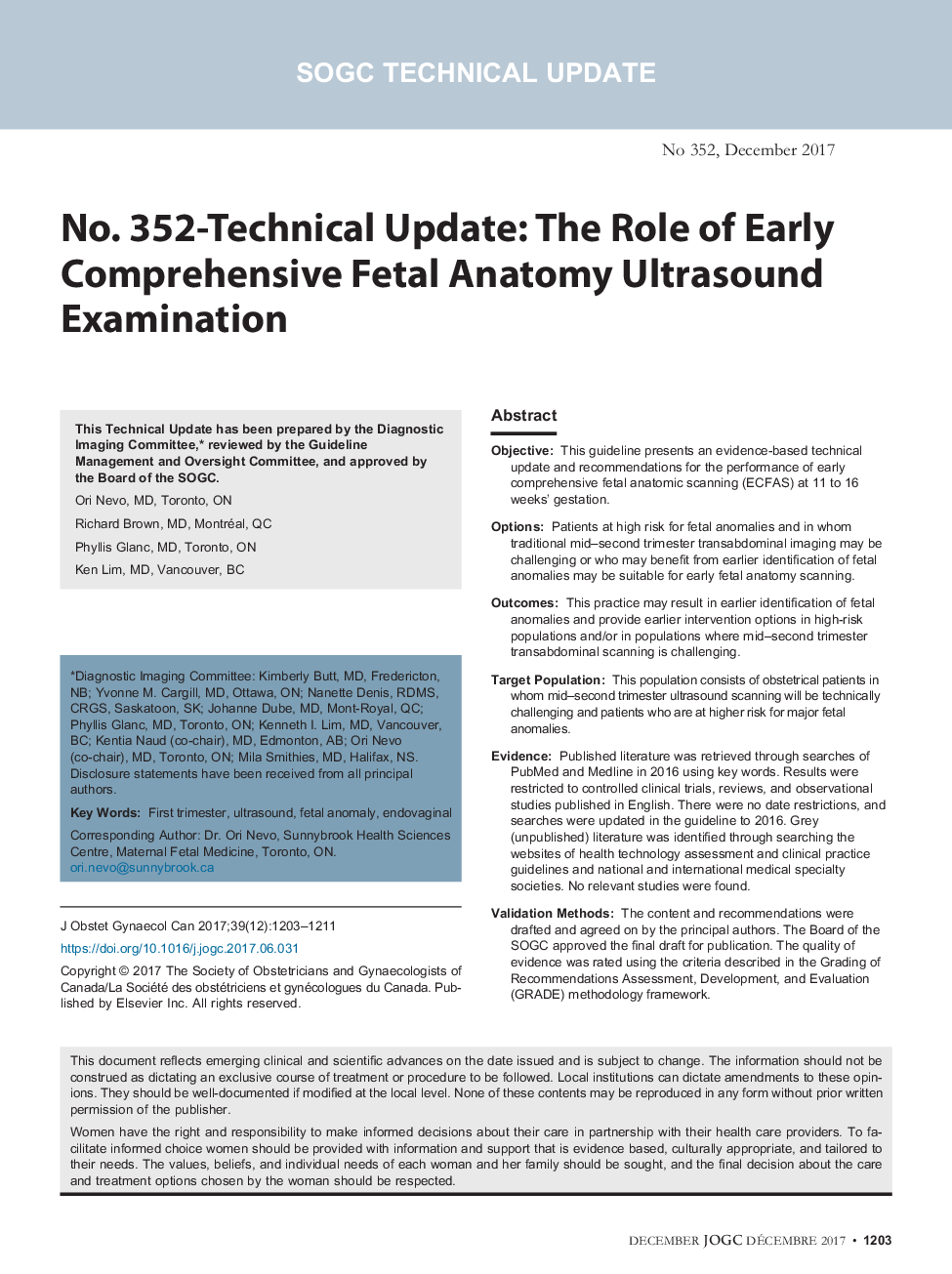| کد مقاله | کد نشریه | سال انتشار | مقاله انگلیسی | نسخه تمام متن |
|---|---|---|---|---|
| 8781904 | 1600650 | 2017 | 9 صفحه PDF | دانلود رایگان |
عنوان انگلیسی مقاله ISI
No. 352-Technical Update: The Role of Early Comprehensive Fetal Anatomy Ultrasound Examination
ترجمه فارسی عنوان
شماره 352-بروزرسانی فنی: نقش بررسی سونوگرافی آناتومی جنس دائمی
دانلود مقاله + سفارش ترجمه
دانلود مقاله ISI انگلیسی
رایگان برای ایرانیان
کلمات کلیدی
موضوعات مرتبط
علوم پزشکی و سلامت
پزشکی و دندانپزشکی
زنان، زایمان و بهداشت زنان
چکیده انگلیسی
ObjectiveThis guideline presents an evidence-based technical update and recommendations for the performance of early comprehensive fetal anatomic scanning (ECFAS) at 11 to 16 weeks' gestation.OptionsPatients at high risk for fetal anomalies and in whom traditional mid-second trimester transabdominal imaging may be challenging or who may benefit from earlier identification of fetal anomalies may be suitable for early fetal anatomy scanning.OutcomesThis practice may result in earlier identification of fetal anomalies and provide earlier intervention options in high-risk populations and/or in populations where mid-second trimester transabdominal scanning is challenging.Target PopulationThis population consists of obstetrical patients in whom mid-second trimester ultrasound scanning will be technically challenging and patients who are at higher risk for major fetal anomalies.EvidencePublished literature was retrieved through searches of PubMed and Medline in 2016 using key words. Results were restricted to controlled clinical trials, reviews, and observational studies published in English. There were no date restrictions, and searches were updated in the guideline to 2016. Grey (unpublished) literature was identified through searching the websites of health technology assessment and clinical practice guidelines and national and international medical specialty societies. No relevant studies were found.Validation MethodsThe content and recommendations were drafted and agreed on by the principal authors. The Board of the SOGC approved the final draft for publication. The quality of evidence was rated using the criteria described in the Grading of Recommendations Assessment, Development, and Evaluation (GRADE) methodology framework.Benefits, Harms, and/or CostsIt is anticipated that there will be an increase in earlier detection of major fetal anomalies in the target population with the benefits of earlier interventions for those individuals. In areas where the service is not available the patient may need to travel to a nearby centre. Early fetal anatomy scanning is considered to be safe and is not expected to cause a risk to the pregnancy.Guideline UpdateEvidence will be reviewed 5 years after publication to decide whether all or part of the guideline should be updated. However, if important new evidence is published before the 5-year cycle, the review process may be accelerated for a more rapid update of some recommendations.SponsorsThis technical update was developed with resources funded by the SOGC.Summary Statements1.Development of fetal organs begins early in the first trimester, with the majority of organs visible by ultrasound evaluation towards the end of the first trimester of pregnancy (High).2.The majority of significant and sonographically detectable fetal anomalies can be detected on early fetal anatomic ultrasound assessment (High).3.Early detection of fetal anomalies allows patients to obtain counselling consultations, and genetic testing at an earlier gestational age, as well as more time to consider options for pregnancy management (High).Recommendations1.Medical personnel (physicians, technologists, or ultrasound practitioners) who have substantial experience or training in the assessment and interpretation of early comprehensive fetal anatomic scanning should be performing the examination (Strong, High).2.The examination can be performed transvaginally, transabdominally, or by both approaches, and the choice for each mode depends on the fetal position, the gestational age, and the experience of the operator (Strong, High).3.Early comprehensive fetal anatomic scanning at 13-16 weeks' gestation should be considered for women who have higher risk for significant fetal anomalies or in whom it is anticipated that a midtrimester transabdominal scan will be technically challenging (High). This scan does not replace the routine 18- to 22-week anatomy scan.
ناشر
Database: Elsevier - ScienceDirect (ساینس دایرکت)
Journal: Journal of Obstetrics and Gynaecology Canada - Volume 39, Issue 12, December 2017, Pages 1203-1211
Journal: Journal of Obstetrics and Gynaecology Canada - Volume 39, Issue 12, December 2017, Pages 1203-1211
نویسندگان
Ori (Principal Authors), Richard (Principal Authors), Phyllis (Principal Authors), Ken (Principal Authors),
